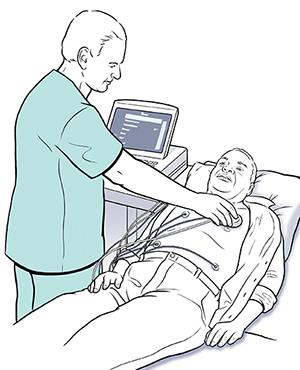Living With Cardiac Resynchronization Therapy (CRT)
Living With Cardiac Resynchronization Therapy (CRT)
Your cardiac resynchronization therapy (CRT) device requires special care. You will also need to make some lifestyle changes. This sheet will tell you how to take care of the device and your health.
Checking your device
You’ll need to have your device checked every 3 to 6 months. This will ensure it is working correctly and has plenty of battery life. This check will be done during visits to your healthcare provider or heart failure clinic.
Newer devices are equipped with an antenna that can communicate with a remote monitor set up in your home. This allows information from your device to be sent to your healthcare provider via the internet or over a landline or cell phone connection. This remote monitoring system can be activated automatically or manually and can reduce the need for frequent office visits to check your device.
Certain tests may be done to make sure the device is helping your heart as much as it can. These tests can include an ECG or echocardiogram. From time to time, the settings may be adjusted. This is done using an electronic wand placed over your device connected to a computer. Newer generations of devices do not require a wand but rather can communicate wirelessly.
Replacing the battery
During your healthcare visits, your device’s battery level will be checked. If it’s low, there’s still plenty of time to replace the battery before it wears out. Most batteries in biventricular pacemakers and ICDs last for several years and newer systems last up to 10 years. Replacing the battery requires a simple and quick procedure when compared to the original implant procedure. It is an outpatient procedure during which the battery and computer in your chest is removed and replaced. Most often the leads do not need to be replaced if working normally and will be connected to the new battery.
Avoiding certain other devices
Very few things will cause a problem with your device. Biventricular pacemakers and ICDs are well protected. Most machines and devices will not interfere. For instance, modern microwave ovens and other basic household appliances should not cause problems. Neither should computers, hair dryers, AM/FM radios, televisions, electric blankets, or cars.
A few things create signals that might interfere with your implant device. These include:
Electromagnetic anti-theft systems. These are often near entrances or exits in stores. Walking past one is OK. But don’t stand near or lean against one.
Strong electrical fields. Some things can generate strong electrical fields. These include radio transmitting towers, heavy-duty electrical equipment, such as arc welders. These should be avoided. A running engine also makes an electrical field. It’s OK to ride in a car. But don’t lean over the open hood of a running car.
Cellular phones. Cell phone can cause a problem, but only if held too close to your device. (Indoor cordless phones are OK.) When using a cellular phone, hold it to the ear on the opposite side of your device. When not using it, carry the phone on the side away from your device.
Very strong magnets. Traditional pacemakers and ICDs are not compatible with MRI scanners and therefore are not recommended. Certain new generations of ICDs are compatible with MRI scanners.
In the rare case that an outside signal does affect it, it’s unlikely the device will be damaged. Typically, the signals will just cause interference. But you may want to have your healthcare provider check your device. If you ever suspect a problem, call your healthcare provider. Other things may interfere with your device. They might be in your workplace, a medical setting, or things you use in your leisure time. Your healthcare provider can review these items with you.
Carrying an ID card
Your device comes with an ID card. This contains important information about the device. You’ll be given a temporary card when the device is implanted. A permanent card will be mailed to you in about 6 weeks. Show the ID card to any healthcare provider, dentist, or other medical professional you visit. Show it to security guards at the airport and other secured areas like courthouses. This way, they know to use special procedures that prevent the security wand from causing a problem with your device.
Staying healthy
When CRT is helping your heart beat, you may have more energy. This makes it easier for you to stay active. Being active exercises your heart and can help you feel better overall. And keeping up with the other parts of your treatment plan can help you live longer and more comfortably. Talk with your healthcare provider about an exercise plan. Stop exercising and call your healthcare provider if you feel any of these symptoms:
Chest pain or discomfort
Burning, tightness, heaviness, or pressure in your chest
Unusual aching in your arm, shoulders, neck, jaw, or back
Trouble catching your breath, especially if this is while you are resting
A racing, slow, or skipping heartbeat
Extreme tiredness (especially after exercise)
Lightheadedness, dizziness, or nausea
Symptoms of heart failure such as rapid weight gain and swelling in your feet, legs, or abdomen
Updated:
October 27, 2017
Reviewed By:
Kang, Steven, MD,Snyder, Mandy, APRN
